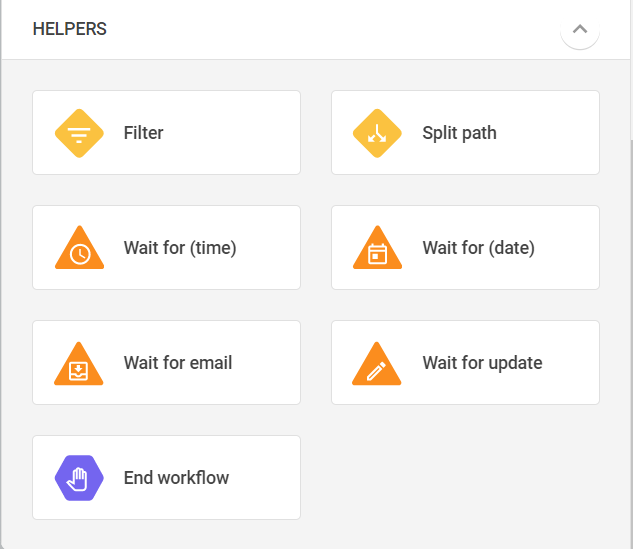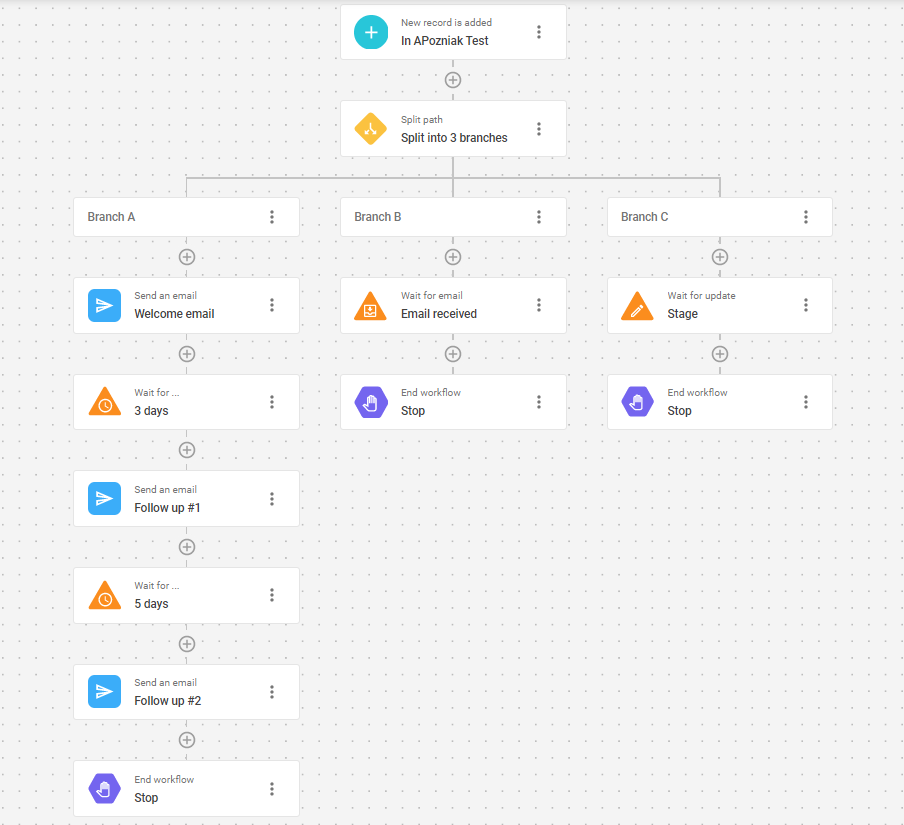Elevate your lead nurturing with these follow-up email sequences designed to guide leads down the funnel.
The reason why you’re not closing more deals could be that you’re not following up with your leads enough.
According to the stats, 60% of customers say no four times before saying yes, whereas 48% of salespeople never even make a single follow up attempt. On top of that, 80% of sales require five follow-up calls, whereas 44% of salespeople give up after one follow-up call.
Successful sales are all about building relationships, staying in touch and following up. You can’t gain someone’s trust after a single email or even a call. The more touchpoints, the better.
But sometimes, follow-ups can be stressful: just one little mistake can be a deal-breaker. So, you must approach following up strategically and know the rules of successful sequences.
As always, The CRM Lab comes to save the day! We’ve prepared a list of key qualities that all successful follow-up email cadences must have, put together follow-up sequence templates for five strategies, and explained how to set up an email cadence in NetHunt CRM.
Key qualities of a successful follow-up email cadence
- Personalised. It’s vital to ensure that your message is tailored to the receiver and their specific needs. Suppose you don’t consider the peculiarities of your previous communication and just send a generic follow-up. In that case, you risk losing your lead’s interest and decreasing the chances of receiving a response. Go beyond sticking a macro-generated first name in the body of your follow-up email - contextualise your sequence.
- Simple and readable. Make sure your follow-up email is straight to the point and doesn’t confuse the reader. When creating a sales follow-up email, it’s best to avoid a graphic design-centred layout. Those feel automated and mass-sent, which defeats the purpose. Moreover, don’t go overboard with your CTAs - stick to just one so you don’t baffle your recipient.
- Short(er). As a rule of thumb, your follow-up messages should be shorter than the first email in the sequence. You don’t need to restate everything you said in your initial email but rather bump it up in the recipient’s inbox or provide some extra details to prompt them to reply to you.
- Respectful. You’re asking your email recipient for the favour of taking some sort of action when sending them a follow-up - make sure you’re polite with your ask and use the appropriate language in your copy.
- Valuable and customer-centric. The follow-up must be beneficial not only for your business but also for the recipient. There needs to be an apparent reason why you’re sending this email and how it can make a difference for the person receiving it. Communicate the value of your offer with the content you send.
- Timely. You need to make sure your follow-up reaches the recipient’s inbox at the right time - when they’re most susceptible to it.
5 Sales Follow-up Email Sequences [Templates]
“Sending Value” Follow-up Strategy
Often, things don’t work out simply because your leads don’t understand the value your business can bring to them. This can be easily fixed with more details and active convincing. Use this follow-up strategy to share more information about your company and the product you offer.
Email #1 (sending in 2-3 days after the initial email):
Email subject:Suggestions about [lead’s goal or problem]
Hi [Name],
How are you doing? I know you haven’t got back to me yet, but I already have a couple of ideas about [lead’s goal or problem]. I have some valuable materials that I thought you’d want to take a look at. Here are the links:
[links or information]
Perhaps, we could also schedule a short call to talk about your current business positions and explore how [your company] could help [lead’s company] grow. Let me know if you have any available slots next week.
Best,
[Your name]
Email #2 (sending in 3-4 days after Email #1):
Email subject: Have you had a chance to think about [lead’s goal or problem] yet?
Hi [Name],
I hope you’ve had a chance to review the information I sent you in the previous email. I’ve made sure to make it extra helpful for [lead’s company], so you can have a fantastic opportunity to solve [lead’s problem].
Let me know if you have any questions. I’m still available for a call to discuss your upcoming business projects and explore how [your product] can accelerate your success. Let’s grow together.
Looking forward to hearing from you!
Best,
[Your name]
Email #3 (sending in 3-4 days after Email #2):
Email subject: Another idea about [lead’s goal or problem]
Hi [Name],
I can’t stop thinking about [lead’s goal or problem]; it hits close to home. I’ve done some research and realised you could benefit from [a solution to lead’s problem tied with the product you offer]. How does that sound?
Want to know more? I'd suggest we have a quick call for a productive discussion. I have a couple of slots free next week - let me know what time works best for you.
Best,
[Your name]
The “Team Discount” Follow-up Strategy
This strategy can encourage your leads to respond to you when you’re sure that your product may be helpful not only for one person from the company but for several of them.
Email #1:
Email subject: Hit revenue goals with [your product] [team discount inside]
Hi [Name],
Teamwork makes dreams work, right? From what I understand about your company, I think your team can benefit from using our product/service. It can improve [insert something that needs improvement and can be solved by your product] and help your company generate more revenue.
Here at [your company name], we’re all about sharing, so I’d like to offer a 10% discount for your team! If you’re interested in this proposition, reply to this email, and we can discuss the offer in more detail.
Sincerely,
[Your name]
Email #2:
Email subject:You can do so much more with [your product] - activate the discount code!
Hi [Name],
It could be that my previous email got lost in your inbox, but I really don’t want your business to miss out on an opportunity to hit your revenue goals.
That’s why I’m following up with a reminder that you can still get a 10% team discount on [your product] to help your team with [something that needs improvement and can be solved by your product].
Let me know if you’re interested in this offer.
Take care,
[Your name]
Email #3:
Email subject:Is hitting your revenue goals no longer a priority?
Hi [Name],
Is your company currently focusing on something other than [insert something that needs improvement and can be solved by your product]? All it takes to redeem your 10% team discount on [your product] is to reply to this email - I’m more than happy to provide more detail about how your business can hit your revenue goals with us.
Let me know what you think.
Best,
[Your name]
The “Never Too Late” Follow-up Strategy
If you tried to reach out to someone via phone or another means of communication but failed, you can send them a follow-up email sequence and have a second chance at connecting with them.
Email #1:
Email subject: [Name], trying to connect with you
Hi [Name],
Sadly, I couldn’t get through to you earlier this day. I was calling about [insert the brief description of the offer].
But your voicemail message suggested I give it another shot on [enter the date and the time]. Till then, you can contact me here or at [insert a cell number].
Sincerely,
[Your name]
Email #2:
Email subject: It takes two to tango, [Name]
Hi [Name],
I’m just bumping this thread up in your inbox. I’ve researched your business, and I think your company and [your product] is a match made in heaven.
Would you be open to finding a time to connect sometime this week and narrow down the list together?
Best,
[Your name]
Email #3:
Email subject: [Name], is it us?..
Hi [Name],
You still have a great offer pending: [insert your offer].
A business in a position similar to yours has started working with us and improved their [a business metric your product helps to improve] by [number/percentage]. You can find out more about this here - [link a case study].
Your business is up next! Just drop me an email, and we could discuss it in detail.
Best,
[Your name]
Want to spice up your email subject lines? We’ve got you covered.
The “A Quick Survey” Follow-up Strategy
Improve your email engagement rates with an interactive follow-up email. It helps to both remind the prospect of your existence and get some data on the efficiency of your email.
Email #1:
Email subject:Are we a good match, you and I? [Quiz Inside]
Hi [Name],
I’m big on making sure my emails only land in the inboxes of people that actually want to receive them - would that be you? Do you want to receive more valuable tips about [the product/the industry relevant to you]?
I’m also big on saving everyone’s time, so there’s no need for you to type out a long response - just send me a digit back:
1 — I am unavailable now; follow up again sometime.
2 — I am not interested in your solutions.
3 — Can I find out more about the offer?
Thank you for your time!
Best,
[Your name]
This strategy doesn’t require any follow-ups - you can send a single email and plan your future actions around the recipient’s response. However, if your email tracking software shows you that the recipient hasn’t opened the email (or opened but didn’t reply), you can send another follow-up.
Email #2:
Email subject:Do you still want to hear from us?
Hi [Name],
Mutual respect is one of [your company name]’s core principles. We value your time and don’t want to be a distraction. If you no longer want to hear from us, please, respond to the previous message, and we won’t bother you again.
If you do want to stay with us… First of all, thank you, it means the world! We can’t wait to share the industry’s juiciest insights with you. But please, do go back to the previous email and let us know we can continue reaching out to you.
Best,
[Your name]
The “Hot on the Trail” Follow-up Strategy
This follow-up sequence is meant for when you’ve already had a business meeting or even a phone call with the lead. You can use this strategy to solidify your positions, secure the next meeting and build upon your further partnership.
Email #1 (immediately after the meeting):
Email subject:Meeting Recap and Our Next Steps
Hi [Name],
Thanks for making time for me today; it was a very insightful meeting. Hopefully, for both of us. Based on what we’ve discussed at the meeting, I believe there is definitely a strong fit for [your company] and [prospect's company].
Just to make things easier for both of us, here’s a quick recap of our conversation, including the features, and the steps we need to take to accomplish our goal.
Objective: Discuss monthly growth figures to determine wins, losses, and areas to improve (for example)
Conversation points:
- [Point 1]
- [Point 2]
- [Point 3]
Action points:
- [Point 1]
- [Point 2]
- [Point 3]
Next meeting: Thursday, 8/16
Best,
[Your name]
Email #2 (1 day after Email #1):
Email subject:[Name], this will help you with the Action points
Hi [Name],
Did you get my calendar invite for Thursday, August 19th at 9 am EST?
Just want to make sure we're all set to go for our Thursday call and ready to move forward. I’ve had a think about the action points we’ve outlined at the meeting and compiled a list of resources that could help you with that. Here are the links:
[Links]
Let me know if you have any questions; I’d be happy to answer them at our next meeting.
Best,
[Your name]
Email #3 (1 day before the meeting):
Email subject:You have an upcoming meeting with [Your Name]
Hi [Name],
Did you get my calendar invite for Thursday, August 19th at 9 am EST?
Just writing to remind you that we have a meeting scheduled for tomorrow. Have you had a chance to go through the information I sent you in the previous email? Let me know so I could better prepare for the call.
I’m looking forward to our meeting - I have some great findings for you!
Best,
[Your name]
How to set up an automated email follow-up sequence
The success of your sales follow-up is determined by the timeliness of your email. If you send the right message to the right contact but do that at the wrong time, your follow-up won’t drive the desired results.
When you have a lot of leads in your pipeline, it’s difficult to send follow-ups to all of them manually. You will either waste all your resources on ensuring that leads receive the appropriate messages at the right time, or miss out on valuable sales opportunities. If you forget to send a follow-up on time, there’s no point in sending it later, when the recipient has already lost track of who you are.
The best way to overcome this problem is to automate the follow-up process using software that offers email automation functionality. For example, NetHunt CRM’s Workflows feature allows you to set up automated email sequences that send the right emails to the right people at the perfect time. Sign up for a free trial to see it on your own!
That way, you won’t have to worry about hitting the ‘Send’ button and can focus on analysing the content of your emails and how they work for your audience.
You simply need to come up with the content for your email sequence and decide on the timing for your follow-ups. Take advantage of the variety of different helpers such as wait time (Wait for Time and Wait for Date) and filters to adapt follow-ups based on user behaviour and customise the perfect workflow for your business!

Here’s an example of how your lead nurturing email campaign can look like with NetHunt CRM:

Never miss a sales opportunity with NetHunt CRM’s automation feature.
Now that you have all the information and the tools needed to send glorious follow-up emails, make sure you put them to good use and don’t miss out on any sales opportunities.
Table of Contents
Crack the sales formula with CRM Lab
Twice a month, receive actionable CRM content to your inbox.



